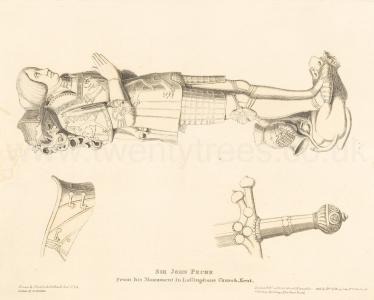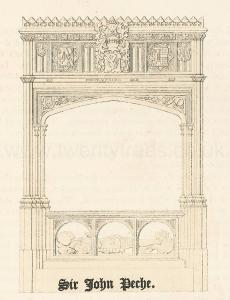Biography of John Peche 1450-1522
In 1450 John Peche was born to William Peche (age 29) and Beatrix Chicheley (age 25) at Lullingstone, Kent.
In 1487 [his father] William Peche (age 66) died.
On 17 Jun 1497 the Cornish rebel army was destroyed at the Battle of Blackheath aka Deptford Bridge.
Richard Guildford (age 47) was created Knight Banneret.
Edward Stafford 2nd Earl Wiltshire (age 27), Henry Willoughby (age 46), Edward Belknapp of Blackfriars in London and Thomas Fiennes 8th Baron Dacre Gilsland (age 25) fought at Deptford, Kent [Map].


Giles Brugge 6th Baron Chandos (age 35), John Hussey 1st Baron Hussey of Sleaford (age 32), Robert Sheffield (age 36), Edward Stanhope 1462-1487, John Peche (age 47) and Robert Constable (age 19) were knighted by King Henry VII of England and Ireland (age 40).


Thomas West 8th Baron De La Warr 5th Baron West (age 40) commanded.
James Tuchet 7th Baron Audley, 4th Baron Tuchet (age 34) was captured by Gruffydd ap Rhys ap Thomas Deheubarth (age 19).
In 1522 John Peche (age 72) died.
Hall's Chronicle 1522. Apr 1522. In this year at the Assize, kept at the castle of Cambridge in Lent, the Justices, and all the gentlemen, Bailiffs and other, resorting thither, took such an infection, whether it were of the savour of the prisoners, or of the filth of the house, that many gentlemen, as Sir John Cut, Sir Giles Alington (age 38) knights, and many other honest yeomen thereof died, and all most all which were there present, were sore sick and narrowly escaped with their lives. And this year also died Sir Edward Poynings, knight of the Garter, Sir John Peche, and Sir Edward Belknap, valiant captains, which were suspected to be poisoned, at a banquet made at Arde, when the two King’s met last.
Effigy of Sir John Peche. The tomb of Sir John Peche, situated on the North side of the chapel attached to Lullingstone Castle [Map], in a state of high preservation, ranks amongst the finest specimens of the time in which it was executed. The canopy is richly ornamented with arms and devices. In the spandrils on the South side are carved the rose and pomegranate, the badges of Henry VIII and Katherine of Arragon: in various parts of the tomb the same badges appear, both single and conjoined. In the spandrils on the North side is seen the Rebus for the name of Peche, formed by peaches and letters united, which shew that the final vowel of the name was accented—Pech-e. The same Rebus is repeated elsewhere on the monument. In the centre of the canopy on the N. and S. sides are escutcheons, bearing the modern arms of Peche— a lion rampant crowned, queue forchée, surmounted by the crest on a wreath of peach branches fruited, a lions head crowned. Beneath the escutcheon on the South side, appears the motto of Sir John Peche, Prest aa Faire, and in the same situation, on the N. side, this inscription, Peche me fieri fecit, most probably allusive to the tomb having been made during the lifetime of Sir John, by his order and direction. The motto is repeated in various places about the monument; amongst the heraldic devices is introduced the ancient coat of Peche, a fess between two chevrons.
The effigy, which lies at the lower part of the tomb, represents the knight, wearing over his armour a rich emblazoned surcoat, wrought on the border with the motto and devices of Peche. Beneath the surcoat and plate armour appears the skirts of a haubergeon, wrought of small plates. The Tasses, which nearly cover the Cuisses, are formed of The double-tailed lion crowned, is placed at the feet of the figure, and not far from it, on the right side, the gauntlets of the knight.
The arms of Sir John Peche, at the bottom of the first page are taken, from a window in the chapel at Lullingstone.
Details:—Plate 1.—Fig. 1. The Gorget:—2, 3, and 4, Motto, and Devices on the Surcoat. Plate II.—Fig. 1. Hilt of the Sword:—2. Specimen of the plates forming the Haubergeon.


Introduction. In one of his customary rambles with the writer, he had the good fortune to meet with the monument of Sir John Peche, or Pechy, as the name is pronounced, at the site of an old baronial mansion, Lullingstone Castle, near Eynsford, in Kent. The effigy afforded a fine specimen of the military costume of the age of Henry the Eighth. The whole was in admirable preservation; but the very circumstance which had contributed to that perfect state, rendered it almost impossible for an artist to gain such an entire view as might enable him to draw it correctly; it was covered by an horizontal slab, distant not more than eighteen inches from the face. (See the Vignette.) This difficulty did not repulse Mr. Stothard. By the aid of a graduated line (he drew all his monuments by scale), he brought all the parts into their due relative proportion, and in two days produced the drawing of which the late Mr. Bartholomew Howlett made a very satisfactory etching, after Mr. Stothard's death, for this work.